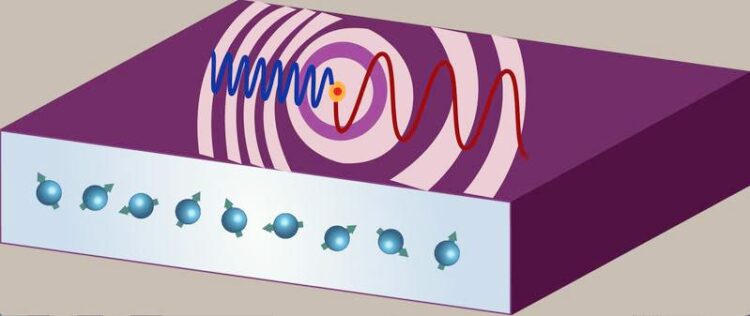A speed limit for spins

The Doppler effect makes the excited magnons move faster on the right-hand side (red waves) than the left one (blue) when the magnons are excited at the source (yellow).
Tao Yu / MPSD
Magnetic insulators are fascinating materials in which the electron spin can form currents without the need for any electrical current. Such ‚spin currents‘ could be used to transmit information. Now a theory research team from the MPSD, Tianjin University (China), and Tohoku University (Japan) reports in Physical Review Letters that, when driven out of equilibrium by magnetic fields, a universal Doppler effect limits the maximal spin current in magnetic insulators. This finding is a surprising analogy to what happens in superconductors driven by electric fields and could provide a fundamental design principle for future nano-devices with computing science and power applications.
Magnets form key components in every computer for information storage. The spins of their electrons, much like tiny compass needles, all point in one direction and sustain wave-like excitations – the so-called magnons. Magnons move through high-quality electrical insulators almost without resistance or the heating that comes with charge currents. Large ‘magnon currents’ are an efficient way to carry information, a key pursuit in spintronics, which makes spin-based technologies highly attractive for low-power information and communication technologies.
However, when a large number of magnons moves in the same direction, they mutually disturb each other and their flow becomes viscous, like honey. Their viscosity grows with the strength of the spin current, making it increasingly difficult for the magnons to move. This begs the question: Can a large spin current even exist and flow smoothly in a magnet when magnons interact strongly with each other?
Now a theory team led by the MPSD has revealed a fundamental speed limit to spin currents in magnetic insulators and identified a close similarity to charge currents in superconductors, The underlying reason for this speed limit lies in the so-called Doppler effect, which causes the spin current to break down once it moves too strong – just like an ambulance siren sounds different once it passes us. The Doppler effect describes the change in wave frequency depending on the relative motion between two objects. This effect is known in superconductors which become unstable once the electron current becomes too large, but now the researchers have discovered an analogous effect in magnetic insulators, highlighting the role of magnon viscosity in spin transport.
When a magnetic thin film is stimulated by stripline microwaves, a spin current (magnon) that flows only in one direction is excited — but this can only happen up to a certain level before the chiral spin pumping effect breaks down. Using advanced theoretical concepts and extensive numerical simulations, the team demonstrated that the magnon frequency is modulated by spin currents that drag the magnons. The frequency of magnons is simply not allowed to become negative, which in turn limits the maximum spin current that a magnetic material can sustain.
“The predicted Doppler effect in magnetic films is an unexpected consequence of the increased viscosity of the confined magnon gas that awaits experimental observation,” says Prof. Gerrit Bauer from Tohoku University. “We were surprised to find this analogy between magnetic insulators and superconductors“, adds Tao Yu, first author and postdoc at MPSD. „Despite their similarities, these systems differ on a fundamental level. Unlike charges, the magnons are not conserved and behave in a more complicated way. It is exciting to see the universality of physical laws emerge in very different systems.”
The researchers also expect that their theory can be extended to other magnetic phenomena and systems, such as magnetization textures or anti-ferromagnets, where the spin viscosity is much less investigated. “We are only beginning to understand the effects of spin viscosity,” explains Michael Sentef, group leader at MPSD. “There are already demonstrations of magnon instabilities based on increasing magnon numbers in magnets, but the instability by spin drag is a different scenario.” Chen Wang, professor at Tianjin University, predicts: “The change of magnon velocity by the Doppler effect depends on the flow direction of the magnon, and thus behaves like a diode for the spins that might be useful for logic devices in the future.”
Wissenschaftliche Ansprechpartner:
Tao Yu, lead author: tao.yu@mpsd.mpg.de
Originalpublikation:
https://journals.aps.org/prl/abstract/10.1103/PhysRevLett.126.137202
Weitere Informationen:
Media Contact
All latest news from the category: Physics and Astronomy
This area deals with the fundamental laws and building blocks of nature and how they interact, the properties and the behavior of matter, and research into space and time and their structures.
innovations-report provides in-depth reports and articles on subjects such as astrophysics, laser technologies, nuclear, quantum, particle and solid-state physics, nanotechnologies, planetary research and findings (Mars, Venus) and developments related to the Hubble Telescope.
Newest articles

First-of-its-kind study uses remote sensing to monitor plastic debris in rivers and lakes
Remote sensing creates a cost-effective solution to monitoring plastic pollution. A first-of-its-kind study from researchers at the University of Minnesota Twin Cities shows how remote sensing can help monitor and…

Laser-based artificial neuron mimics nerve cell functions at lightning speed
With a processing speed a billion times faster than nature, chip-based laser neuron could help advance AI tasks such as pattern recognition and sequence prediction. Researchers have developed a laser-based…

Optimising the processing of plastic waste
Just one look in the yellow bin reveals a colourful jumble of different types of plastic. However, the purer and more uniform plastic waste is, the easier it is to…


